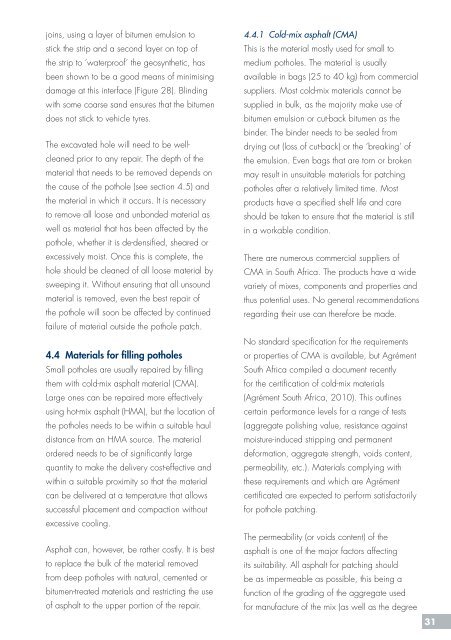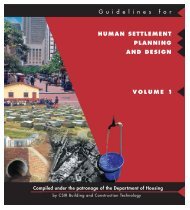POTHOLES: - CSIR
POTHOLES: - CSIR
POTHOLES: - CSIR
- No tags were found...
You also want an ePaper? Increase the reach of your titles
YUMPU automatically turns print PDFs into web optimized ePapers that Google loves.
joins, using a layer of bitumen emulsion tostick the strip and a second layer on top ofthe strip to ‘waterproof’ the geosynthetic, hasbeen shown to be a good means of minimisingdamage at this interface (Figure 28). Blindingwith some coarse sand ensures that the bitumendoes not stick to vehicle tyres.The excavated hole will need to be wellcleanedprior to any repair. The depth of thematerial that needs to be removed depends onthe cause of the pothole (see section 4.5) andthe material in which it occurs. It is necessaryto remove all loose and unbonded material aswell as material that has been affected by thepothole, whether it is de-densified, sheared orexcessively moist. Once this is complete, thehole should be cleaned of all loose material bysweeping it. Without ensuring that all unsoundmaterial is removed, even the best repair ofthe pothole will soon be affected by continuedfailure of material outside the pothole patch.4.4 Materials for filling potholesSmall potholes are usually repaired by fillingthem with cold-mix asphalt material (CMA).Large ones can be repaired more effectivelyusing hot-mix asphalt (HMA), but the location ofthe potholes needs to be within a suitable hauldistance from an HMA source. The materialordered needs to be of significantly largequantity to make the delivery cost-effective andwithin a suitable proximity so that the materialcan be delivered at a temperature that allowssuccessful placement and compaction withoutexcessive cooling.Asphalt can, however, be rather costly. It is bestto replace the bulk of the material removedfrom deep potholes with natural, cemented orbitumen-treated materials and restricting the useof asphalt to the upper portion of the repair.4.4.1 Cold-mix asphalt (CMA)This is the material mostly used for small tomedium potholes. The material is usuallyavailable in bags (25 to 40 kg) from commercialsuppliers. Most cold-mix materials cannot besupplied in bulk, as the majority make use ofbitumen emulsion or cut-back bitumen as thebinder. The binder needs to be sealed fromdrying out (loss of cut-back) or the ‘breaking’ ofthe emulsion. Even bags that are torn or brokenmay result in unsuitable materials for patchingpotholes after a relatively limited time. Mostproducts have a specified shelf life and careshould be taken to ensure that the material is stillin a workable condition.There are numerous commercial suppliers ofCMA in South Africa. The products have a widevariety of mixes, components and properties andthus potential uses. No general recommendationsregarding their use can therefore be made.No standard specification for the requirementsor properties of CMA is available, but AgrémentSouth Africa compiled a document recentlyfor the certification of cold-mix materials(Agrément South Africa, 2010). This outlinescertain performance levels for a range of tests(aggregate polishing value, resistance againstmoisture-induced stripping and permanentdeformation, aggregate strength, voids content,permeability, etc.). Materials complying withthese requirements and which are Agrémentcertificated are expected to perform satisfactorilyfor pothole patching.The permeability (or voids content) of theasphalt is one of the major factors affectingits suitability. All asphalt for patching shouldbe as impermeable as possible, this being afunction of the grading of the aggregate usedfor manufacture of the mix (as well as the degree31

















